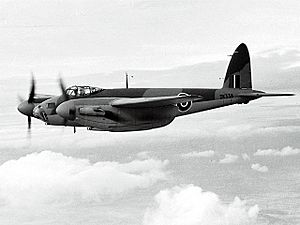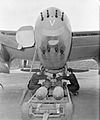De Havilland Mosquito facts for kids
Quick facts for kids DH.98 Mosquito |
|
|---|---|
 |
|
| Mosquito B Mk IV serial DK338 before delivery to 105 Squadron. This aircraft was used on several of 105 Squadron's low-altitude daylight bombing operations during 1943. | |
| Role |
|
| National origin | United Kingdom |
| Manufacturer | de Havilland Aircraft Company |
| First flight | 25 November 1940 |
| Introduction | 15 November 1941 |
| Retired | 1963 |
| Status | Retired |
| Primary users | Royal Air Force |
| Produced | 1940–1950 |
| Number built | 7,781 |
| Unit cost | £9,100 (1951) |
The De Havilland Mosquito is a British aircraft from the World War II. The Mosquito was a successful design. Originally intended to be a bomber, the type was very fast, could fly a long way and carry heavy loads. Therefore, it was and it was adapted to a number of other roles such as fighter, night fighter, night intruder, attack, reconnaissance and pathfinder.
Images for kids
-
W4050 being restored at the de Havilland Aircraft Heritage Centre near St Albans
-
A preserved Mosquito at the U.S. Air Force Museum (former TT Mk 35 which was restored to B Mk XVI configuration). Note the air and oil coolant radiators in the leading edge of the wing, intake for the two-stage Merlin's intercooler radiator behind the propeller blade, and the carburettor intake with ice guard behind and below.
-
American F-8 Mosquito nose; USAAF markings, PRU Blue finish at the National Museum of the United States Air Force.
-
Bombing of the Gestapo headquarters in the Shellhus, Copenhagen, Denmark, in March 1945. A Mosquito pulling away from its bombing run is visible on the extreme left, centre.
-
A de Havilland Mosquito of the RAF Banff Strike Wing attacking a convoy evacuating German troops in the Kattegat on 5 April 1945. A flak ship and a trawler were sunk.
-
Mosquito B Mk IV Series 2, DK338, built in September 1942 and delivered to 105 Squadron, becoming GB-O.
-
NF Mk XIII of 256 Squadron, with the "bull nose", caught in the beam of a Chance light on the main runway at Foggia, Italy, before taking off on a night intruder sortie.
-
Mosquito FB Mk XVIII NT225 of 248 Squadron Special Detachment. Note the 57 mm Molins gun and streamlined blister used to accommodate the automatic loading mechanism.
-
B Mk IV DK336 of 105 Squadron being prepared for Operation Oyster, December 1942. This aircraft crashed near Shipham while returning from Cologne on 27 January 1943
See also
 In Spanish: De Havilland DH.98 Mosquito para niños
In Spanish: De Havilland DH.98 Mosquito para niños



























